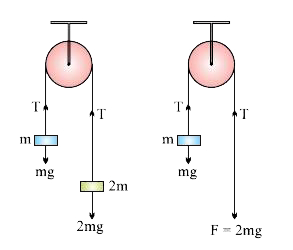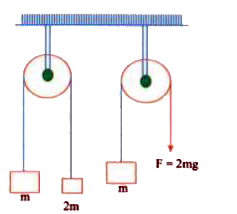The pulley arrangements of Figs. (a) and (b) are identical. The mass of the rope is negligible. In (a) the mass m is lifted up by attaching a mass 2m to the other end of the rope. In (b), m is lifted up by pulling the other end of the rope with a constant downward force F=2mg. The acceleration of m is the same in both cases

Case (i) For mass m
T−mg=ma
For mass 2m
2m−T=2ma

From (i) and (ii)
a=g/3
Case(ii) T−mg=ma′
2mg−mg=ma′ [∴T=2mg]
∴ a′=g
Hence, a<a′

Topper's Solved these Questions
- HEAT AND THERMODYNAMICSBook:SUNIL BATRA (41 YEARS IITJEE PHYSICS)Chapter:HEAT AND THERMODYNAMICSExercise:JEE Main And Advanced
Explore 219 Videos
- MECHANICAL PROPERTIES OF MATTER AND FLUIDSBook:SUNIL BATRA (41 YEARS IITJEE PHYSICS)Chapter:MECHANICAL PROPERTIES OF MATTER AND FLUIDSExercise:Subjective Problems
Explore 1 Video
Similar Questions
The pulley arrangement of fig. are identical. The mass of the rope is negligible. In (a) mass m is lifted up by attaching a mass (2 m) to the other end of the rope. In (b), m is lifted up by pulling the other end of the rope with a constant downward force F =2 mg. In which case, the acceleration of m is more ?

View SolutionThe pulley arrangements of fig (a) and (b) are identical. The mass of the rope is negligible. In (a) the mass m is lifted up by attaching a mass 2 m to the other end of the rope. In (b) m is lifted up by pulling the other end of the rope with a constant downward force F = 2 mg. Which of the following is correct?

View Solution
Knowledge Check
In fig mass m is lifted up by attaching a mass 2m to the other end of the string while in fig
(b) m is lifted by pulling the other end of the string with a constant force F=2mg then:
 Aacceleration of m in the two situations is same and non - zeroBacceleration of m in situation
Aacceleration of m in the two situations is same and non - zeroBacceleration of m in situation
(a) is more than that of in situation(b)Cacceleration of m in situation
(a) is less than that of in situation
(b)Dacceleration of m in the two situations is same and equals to zeroThe pulley arrangements shown in figure are identical, the mass of the rope being negligible. In case I the mass m is lifted by attaching a mass 2m to the other end of rope with a constant downward force F=2mg, where g is acceleration due to gravity The acceleration of mass m in case I is
 .AzeroBmore than that is case IICless than that in caseDequal to that in case II
.AzeroBmore than that is case IICless than that in caseDequal to that in case IIThe pulley arrangements shown in figure are identical, the mass of the rope being negligible. In case I, the mass m is lifted by attaching a mass 2m to the other end of rope with a constant downward force F = 2mg, where g is acceleration due to gravity. The acceleration of mass m in case I is
 AzeroBmore than that in caseCless than that in case IIDequal to that in case II
AzeroBmore than that in caseCless than that in case IIDequal to that in case II
The pulley arrangement in Fig are identical .The mass of the rope is negligble in figure the mass m is lifted up by atteched a mass 2m to the other end of the rope . In (b), m is lifed up by pulley the other end of the rope with a constant in both cases

View SolutionA mass of 1kg attached to one end of a string is first lifted up with an acceleration 4.9m/s2 and then lowered with same acceleration What is the ratio of tension in string in two cases .
View SolutionFigure shown two pulley arrangements for lifting a mass m . In case-1, the mass is lifting by attaching a mass 2m while in case-2 the mass is lifted by pulling the other end with a downward force F=2mg . If aa and ab are the accelerations of the two masses then (Assume string is massless and pulley is ideal).

View SolutionA block of mass M is attached to the lower end of a vertical rope of mass m. An upward force P acts on the upper end of the rope. The system is free to move. The force exerted by the rope on the block is PMM+m
View SolutionAn object of mass 5 kg is attached to the end ofa rope. If the rope is pulled upward with an acceleration 0.30ms−2, what is the tension in the rope?
View Solution